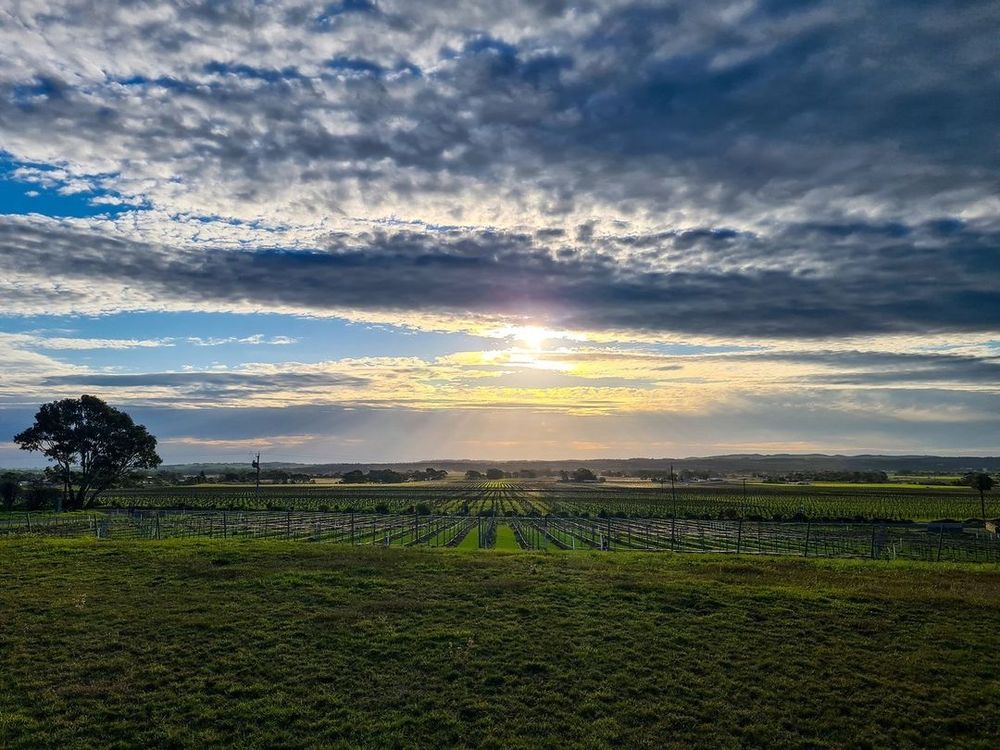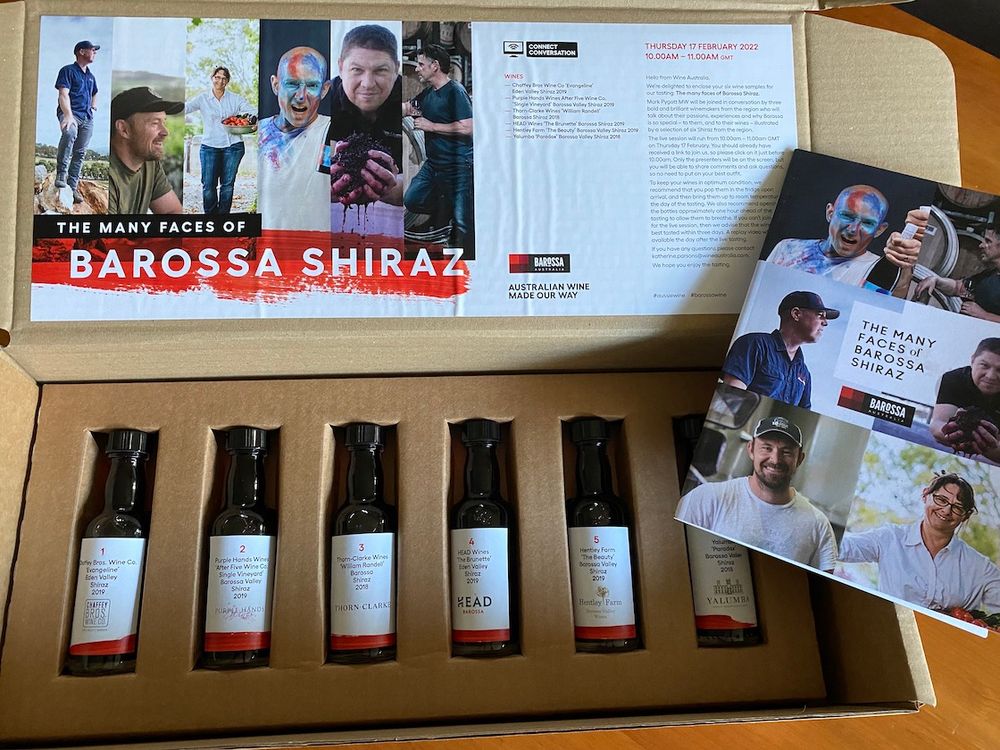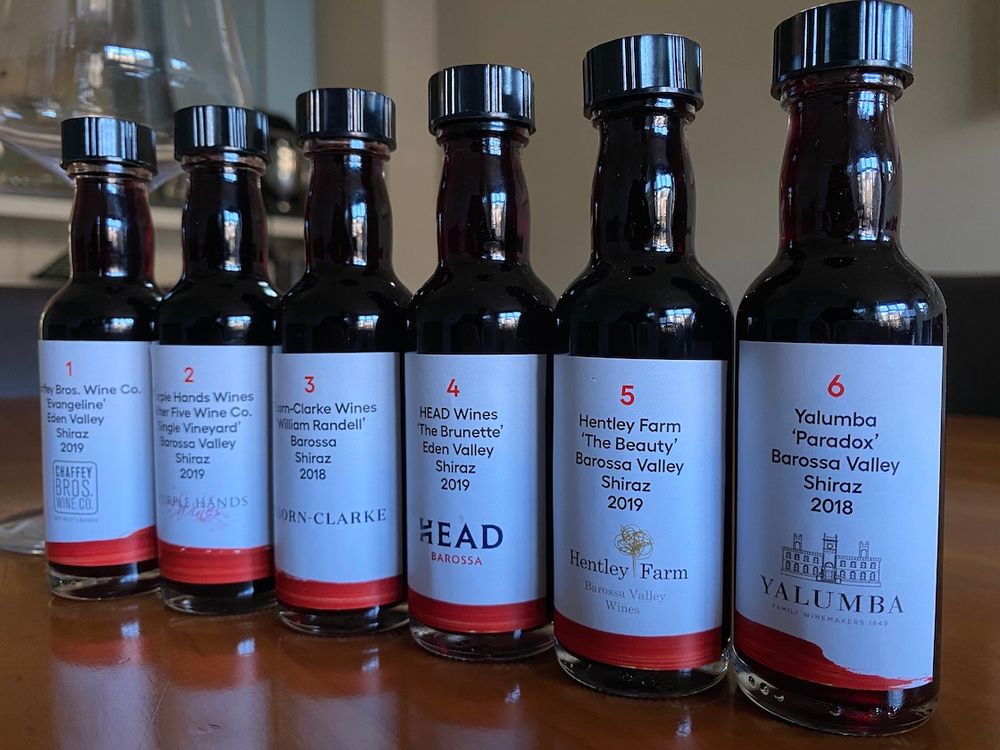The Many Faces of Barossa Shiraz webinar-tasting involved the wines of Chaffey Bros, Purple Hands Wines, Hentley Farm, Thorn-Clarke, Yalumba and Head Wines with Mark Pigott MW chairing the debate.
“We all know that if you drive forwards, looking only in the rear vision mirror, you’re going to crash so I think all of us are always glancing to see where we’ve come from, but we also like to look forwards,” says Daniel Chaffey Hartwick the winemaker at Chaffey Bros Wine Co.
Hartwick is discussing the extent to which Barossa-based winemakers need to keep one foot in the past whilst also trying to move the style of Barossa Shiraz forwards, away from the dense, dark, high alcohol beasts of the past, and more towards contemporary styles – wines that are more finessed, nuanced and balanced.
Andrew Quin winemaker at Hentley Farm Wines adds “One of the challenges we have as winemakers is trying to move with the trend and make the best expression of the site and region as we can… but we have to be careful how far we are moving – you have to take baby steps along the way.”

Many Faces of Barossa Shiraz tasting 17th February 2022, Mark Pygott MW (right screen) Craig Stansborough, Daniel Chaffey Hartwick, Andrew Quin, Amanda Longworth (l-r, Left Screen)
Continuing to evolve but be relevant
Barossa expert Mark Pygott MW, who was chairing the event, explained that one of the reasons for holding an international spotlight called ‘The Many Faces of Barossa Shiraz’ was because many people still have an outdated concept of what Barossa Shiraz actually is.
“Some consumers and people within the trade still feel that they know what Barossa Shiraz is because they’ve had a couple of big brands of wines produced in the Barossa, and maybe their experience has been one dominated by this idea, that Barossa is all about full throttle, dense dark, heavily-oaked, high in alcohol wines.”
“Well I think it’s obvious… that if you work in a Mediterranean climate like the one enjoyed by the Barossa then alcohol is always going to naturally sit around 14 degrees or so but, other than that, the diversity of styles here is really significant.”

“Winemakers tell you that 95% of the magic happens in the vineyard.”
Recalling a conversation that he had had with Yalumba winemaker Louisa Rose, Pygott adds.
“Rose said that her predecessor (Brian Walsh) set the standard that still impacts on the wine styles that Yalumba are producing today, but that it was really important to continue to evolve and be relevant. I really liked what she said, that ‘tradition gives her the confidence to make wines suitable for today’.”
“That idea of tradition, that idea of whether you’re a game-changer or just a custodian or caretaker of the history of the region, is an interesting one,” Pygott continues “… that there is a great deal of respect for the region in which you work and the people who have come before you, but it would be foolish to think that (replicating) what had been done in the past was the only way to honour the people who have come before you – all it would really mean would be that you would become an anachronism that the wines would no longer be suitable for the modern world and, instead, what we find is that Barossa (today) is a truly vibrant, brilliant, innovative place to visit, taste, and make wine.”
Craig Stansborough from Purple Hands Wines adds a caveat that winemakers like him have to keep realistic about where he wants to take the category and what the market is still expecting from Barossa Shiraz.
“When you’re making wine you have to ask yourself ‘am I making wine for myself or for my customer?’ Because sometimes you get carried away and you taste it and think ‘this is fantastic!’ but my consumer, the people who are buying my wine aren’t going to understand what the hell I’m doing here.”

Tasting pack, February 17, 2022
Pygott says that our focus should be on the conviction and the skills of the winemaker, rather than the influence of terroir, bypassing Wine Australia’s, literally, ground-breaking geological study the ‘Barossa Grounds Project’ which critic Andrew Jefford has hailed as “a more coherent and systematic account of terroir than any I have seen emanate from Burgundy or Bordeaux.”
“I was very keen to avoid falling into the very legitimate trap of focusing on the topography and the soil and the differences on altitude and aspect that such a focus would naturally have led to,” Pigott says.
“Out of humility or perhaps a desire to stay on message, estate owners and winemakers – we’ve all heard this – tell you that 95% of the magic happens in the vineyard. I think… I know, that the winemaker is much more than 5%… they set the tone. When I spoke to Louisa Rose at Yalumba a couple of weeks ago she said to me that even when she chooses to do nothing that decision is based on knowledge and understanding.”
“I think it’s really important to remember so, instead, we will be focusing on the people whose job it is to steer the fruit through fermentation and maturation to a point where the vineyard, region and the tradition of the Barossa is respected and represented appropriately.”
Trying to control alcohol
The wines’ naturally high alcohol facilitated by the climate is always an issue in this region and the winemakers agreed that they were doing whatever they could to control it, by intervening at the most appropriate time.
“It is one of the challenges here,” says Stansborough, “we would like to do 13.5% wines every year but the climate doesn’t allow you to. Indigenous yeast tends to create less alcohol, as do open fermenters, and storage conditions for barrels is important, to keep them where it is cool and humid (with less evaporation)… there are lots of little things we can do to control it a little bit.”
Andrew Quin says that he now picks one section of his Shiraz early with a lower percentage of alcohol which would be too “lean and green as a standalone wine” but works as part of a blend. Stansborough adds that in the vineyards, through vine management, there are many techniques of keeping the vines cooler, however, “if Mother Nature decides to have a warm summer it’s difficult” an issue compounded by smaller crop yields, through everyone trying to ‘grow premium’ which means coping with quicker rises in sugar and fruit all ripening at the same time.
When asked if the winemaking process involved a degree of ego, Stansborough replies “that’s partly ego, partly experience – conviction is probably more of a key word I think.”
Andrew Quin says “You’ve got to be passionate about what you’re doing you’ve got to believe in what you’re doing so there’s got to be an element of ego in that – you could argue that you’ve got to need a bit of that.”
“I think the problem is that someone once called winemakers ‘rock stars’ and some of them believed that,” says Hartwick, “But I think we’re past that now, we all like to think we can add something to our region, because we appreciate it and we all want to express it in a different way – that could be perceived as ego perhaps – but it’s more about wanting to share where we’re from.”
So how were the six Barossa Shiraz tasting?

Chaffey Bros Wine Co, ‘Evangeline’, Eden Valley Shiraz 2019
14.5% abv (RRP £21.50, Enotria&Coe)
From fruit grown in a Riesling vineyard on a cooler shelf region on the edge of the Adelaide Hills, Daniel Chaffey Hartwig set out to show a different side of Barossa with a wine that has brightness and pretty aromatics – choosing minimal intervention, with 18 months in large format oak. 11% whole bunch is used to open and “stretch out the palate…some of these Barossa wines can be confronting with a wall of fruit and tannin, but whole bunch opens out the weave,” he says. Hartwig has made a wine with brightness, blue fruit, licorice and menthol although the 14.5% abv shows… “you can’t take the boy out of Barossa.”
Pygott found in the wine “A lovely dark fruit character with a herbal edge to it, like a peppery gunpowder note. Gravelly tannins, a touch of sweet pastry, vanilla, nice and long, with a warmth, but the alcohol doesn’t sit outside the frame of the wine.”
Purple Hands Wines, After Five Wine Co, Single Vineyard Barossa Valley Shiraz 2019
14% abv, (RRP £31, The Wine Way)
Winemaker Craig Stansborough says he’s not afraid of tannin which ties in with him being a lover of Piemonte and its wines. “They have beautiful tannins and Barossa Shiraz can handle that but you have to be on the ball.” The 2019 vintage’s small berries meant that the wines have a lot of structure from a young age “as soon as you make the decision to pick you envision what you are going to make,” he says adding that for him it is all about how a wine flows. “I want wines to flow – the flavours, textures and tannins – and to be the same from start to finish. Nebbiolo can create incredible beasty wines with big tannins but they still flow, and you have that in Barossa. It’s not easy to achieve that from a winemaking perspective, but once everything is in its right place – that’s when it flows.”
Pygott says he found the wine “Gruff around the edges – but not in a negative way,” on first opening it “was a touch reductive, quiet and tight, but with air feels more mature and a bit more open; the fresh acidity lends a vibrancy to the wine, the tannins are a bit more chewy at this stage of development with a lovely mix of red and black fruit – the tannin and acid structure promises that it will evolve quite excitedly over the years.”
Thorn-Clarke Wines, ‘William Randell’ Barossa Shiraz 2018
14.5% abv, (RRP £30, Fine Wines Direct)
From Barossa’s Northern Grounds, winemaker Peter Kelly has made an ‘old school’ Barossa Shiraz that expresses the thumbprint of the region, “including things like density” but with perfume and balance. Kelly describes his winemaking being like a rubber band with the style stretching back a generation or two generations steering the fruit in a direction that recognises the past.
Pygott picked up chocolate, dark cherry, vanilla and wood “which, with the cosseting warmth of the alcohol, is deeply appealing. This is a wine that impresses people – it is easy, sweet-fruited and dense – while retaining good levels of acidity amongst all this richness as well.”
Hartwick adds “I love the William Randell because, even though it’s a nostalgic look back, it’s in the best way possible.”
Head Wines, ‘The Brunette’ Barossa Shiraz 2019
14.5% abv. (RRP £45 Amathus Drinks)
“Old wines captivate me and no place lets me express that better than Barossa,” says Alex Head of Head Wines who has made this old vine Shiraz from 80-year-old vines, 500m up in the Eden Valley. The wine has had 20% whole bunch and spends 15 months on its fine lees in 30% new French oak.
Leading the tasting, Pygott says “It’s the most obviously reductive wine on first opening but then it blows off after five minutes and is pristine aromatically. It has red fruit – raspberries and redcurrants – and gets darker in the glass as it unwinds; there’s a grippy-ness to the tannins and a savouriness to balance the sweetness. It’s a serious wine and has tension in it that needs to relax; the acidity is cleansing and there’s a bit of warmth from, but not dominated, by the alcohol.”
Wine writer Joe Wadsack described it on the live chat as “Graillot on steroids.”
Hentley Farm ‘The Beauty’ Shiraz 2019
15% abv, (RRP £38, Carson & Carnevale)
From Barossa’s Western Ridge, this wine is co-fermented with 3% Viognier skins and spends 20 months in 35% new French oak. Asked whether ‘power’ is Barossa Shiraz’s calling card, winemaker Andrew Quin replies “Power is one of the things on the calling card but you’ve also got fruit and colour. Modern Barossa is about having finesse, elegance, poise and great length, which comes from picking the fruit a bit earlier, and you have to work hard to have that soft silky tannin structure,” he says, adding that he aims to capture a cool fragrance, contrasting it with another of his wines called The Beast which has “a lot more to it.”
Pygott found the wine: “Pretty on the nose, floral; the tannins are beautiful – immediately supple and mouth-coating – The Beauty is very aptly named it has refreshing levels of acidity, you don’t feel the alcohol gets in the way or steps outside the frame of the wine.”
Yalumba ‘Paradox’ Barossa Valley Shiraz 2018
14% abv, (RRP £28, John Fells)
“Shiraz is inherently an aromatic variety, I have never forgotten this and appreciate how different terroirs show off this character,” says winemaker Louisa Rose who has made this Northern Grounds Shiraz from vines aged up to 60 years old, hailing from 280-metres-high vineyards with sand over clay soils. Using indigenous yeast, open-top fermenters and ageing in French oak puncheons (8% new) are ways of keeping the alcohol in check and keeping a brightness to the fruit.
Pygott describes the wine as “Bright, pretty, elegant, very Yalumba in style, with warmth in the finish, with just enough grip and tannin to feed through to its persistent length.”









































